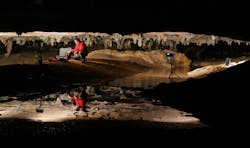Researchers Discover Ancient Drawings in a Cave Using Photogrammetry
Researchers used 3D photogrammetry to uncover ancient mud glyphs, or drawings, inscribed on a ceiling of a cave in Alabama.
Using photogrammetry, a software-based technique that creates 3D models, the researchers produced a high-resolution topographic 3D record of the very faint drawings, including images that were invisible during their in-person visits to the site.
Stephen Alvarez, photographer and founder of the Ancient Art Archive (Sewanee, TN; www.ancientartarchive.org); board member Jan Simek, a professor and archaeologist at the University of Tennessee; and Alan Cressler, a photographer, undertook the project and reported on their findings in the journal Antiquity (https://bit.ly/3NlyAkm).
“We knew the glyphs existed, but they were so faint it was impossible make out the full images,” they wrote in a news release describing the project. Using photogrammetry, they discovered “thousands of additional glyphs and images, most outside the canon of Native American iconography previously detected in the Southeastern United States.” Several of them appear to be human forms in regalia while another depicts a serpentine.
The mud glyphs, found in a 25 × 20 m dark chamber of the cave, are very large, including a drawing measuring 1.81 m long. The researchers also noted that the space in which the ancient artists would have applied their craft was cramped with a very low ceiling, meaning they would not have been able to see the entire drawing as they created it. In fact, without the 3D modeling techniques, the researchers wouldn’t have been able to do so either.
The Photogrammetry Process
“What photogrammetry and 3D modeling allow us to do is to abstract that ceiling and remove things that are distracting to us, like the color of the cave, water droplets, things like that, and shine virtual lights across the mesh to really look at the engravings that are there and to see them without the distraction of the rest of the cave,” explains Alvarez.
In the first step in the photogrammetry process, the researchers took 16,000 photographs—each of which overlapped neighboring images by 80%—to use as the basis for two 3D models of the engraved ceiling and a third 3D model spanning the cave’s entrance through the chamber with the drawings. The 3D models, which are interlinked, can be manipulated virtually to examine the drawings in detail.
They used a Canon (Tokyo, Japan; https://global.canon/en/) 5D MK IV camera with a 30-MPixel sensor and a Canon L series 24-70-mm f2.8 lens set to 24 mm and a Canon 5DS DSLR camera with a 50-MPixel sensor and a Sigma 24-mm Art Series lens. The pictures were taken by hand and with a tripod. For the pictures of the ceiling, they also mounted the camera on a 12-foot movable track, allowing the camera’s sensor to be pointed upward.
To illuminate the area, they used an on-camera flash. For some of the images, they also used four LED lights mounted on tripods, which were positioned strategically to illuminate the portion of the ceiling they were photographing.
Once back in the office, Alvarez used the photogrammetry software, Agisoft Metashape (St. Petersburg, Russia; www.agisoft.com), to create the 3D models. The software calculates the camera positions used to take the images by examining the photos and overlaps. It then triangulates the pixels to create a 3D point cloud. Using the point cloud it created, the software produces a mesh of the surface to be modeled; the mesh is then textured with the original images, creating the 3D model.
To interpret the models, Alvarez uploaded them into software from Autodesk (San Francisco, CA, USA; www.autodesk.com) called Maya. “It lets you look at things in different ways. You can texture things. You can take the textures out. You can just look at the mesh. You can shine a light on it from any direction you want,” Alvarez says.
Alvarez expects the team’s work to lead to more extensive use of photogrammetry and 3D modeling in archeology. “What it means is that using relatively inexpensive tools—using a digital camera and a flash—you can resolve incredibly fine engravings that are otherwise invisible. You don’t have to throw a $250,000 lidar unit at a site, you can do it with these inexpensive tools. That opens up a new way of not just discovering the new engravings but being able to quantify and interpret them.”
About the Author
Linda Wilson
Editor in Chief
Linda Wilson joined the team at Vision Systems Design in 2022. She has more than 25 years of experience in B2B publishing and has written for numerous publications, including Modern Healthcare, InformationWeek, Computerworld, Health Data Management, and many others. Before joining VSD, she was the senior editor at Medical Laboratory Observer, a sister publication to VSD.

